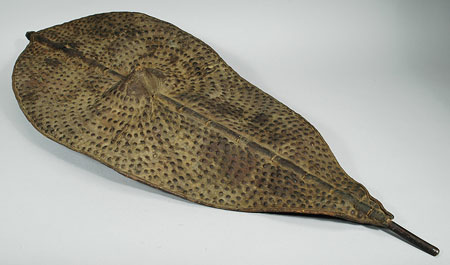Accession Number:
1937.34.43
Country:
Sudan
Region:
[Southern Sudan]
Cultural Group:
Nuer
Date Made:
By 1936
Materials:
Animal Hide Skin , Wood Plant , Grass Fibre Plant
Process:
Repoussť , Carved , Polished , Twisted , Knotted , Stitched Repaired (local)
Dimensions:
Central pole L= 1337, diam = 21 mm; shield body L = 1180, W = 508, th at edge = 9, cord W = 8.2, th = 4.5 mm [RTS 18/1/2005].
Weight:
>1000 g
Other Owners:
Collected by Edward Evan Evans-Pritchard during his last period of fieldwork amongst the Nuer between October and November 1936, where he worked amongst the Nuer Leek in the area west of the Nile [RTS 6/7/2004].
Field Collector:
Edward Evan Evans-Pritchard
PRM Source:
Edward Evan Evans-Pritchard
Acquired:
Donated 1937
Collected Date:
October to November 1936
Description:
Shield made from a large piece of animal hide, moulded to shape when wet.
This consists of a roughly lentoid-shaped body with rounded top edge and curved sides that taper to a point at the base.
The central part has been pushed outwards to form a conical boss, and the outer edges rolled over from behind to form a thickened rim.
A series of 16 pairs of slits have been cut in a row that runs down the centre of the body; these allow loops to be pulled out from the surface, and a central pole to be threaded through them, that acts as both support and handle, with the grip area lying directly below the raised boss, whose hollow underside allows the owner's hand to fit comfortably around the grip.
The cut gaps visible on the outer face of the shield have an almost hourglass-shaped form.
The skin would have been fitted over this pole while wet, with the loops tightening over the wood as they dried and fixing it securely in place.
The surface has also been closely worked to give it a textured appearance, covering it with a series of small raised bumps that have been pushed up from the underside in repoussé technique; these are in rows radiating around the central boss, then becoming more closely spaced over the rest of the body.
There are a few cut marks across the outer surface, suggesting that the shield has seen some defensive use.
This may also explain a local repair on the upper body, where a vertical tear has been sewn together using a narrow strip of hide.
The outer surface is dark brown (Pantone 440C), while the underside is a reddish brown colour (Pantone 476C).
The central pole has been carved from a single piece of light coloured wood with a circular section.
This has a conical knob carved at the top and a flat-cut base; the knob, and the inside exposed areas of the wood have been burnt a reddish brown colour (Pantone 476C), with their surface polished.
A length of cord has been wrapped once around the handle area, and then the loose ends tied together to create a loop that could be used for suspension.
This has been made from 2 bundles of orangey brown grass fibre plaited together (Pantone 722C); a knot along the body indicates that the original cord was lengthened by the addition of a further piece at some stage, although the added section matches the original in colour and design.
The shield is complete, and in good condition, although there is a split in the knobbed end and the ends of the grass cord are fraying.
The central pole is 1337 mm long, with a diameter of 21 mm; the shield body is 1180 mm long, 508 mm wide and 9 mm thick at the edges, while the suspension cord is 8.2 mm wide and 4.5 mm thick.
For a similar style of shield, see 1946.8.97, collected from the Lake No area, and also 1946.8.98. The form is also found amongst the Dinka, also with raised knob decoration (see D. Plaschke & M.A. Zirngibl, 1992, African Shields, cat. 33, p. 50). According to information provided for 1946.8.97, the impressed 'knob' decoration on these types of shields was made by hammering pebbles into the skin while it was still soft.
Currently on display in the Upper Gallery, case 26A.
Rachael Sparks 18/9/2005.
For a similar style of shield, see 1946.8.97, collected from the Lake No area, and also 1946.8.98. The form is also found amongst the Dinka, also with raised knob decoration (see D. Plaschke & M.A. Zirngibl, 1992, African Shields, cat. 33, p. 50). According to information provided for 1946.8.97, the impressed 'knob' decoration on these types of shields was made by hammering pebbles into the skin while it was still soft.
Currently on display in the Upper Gallery, case 26A.
Rachael Sparks 18/9/2005.
Primary Documentation:
Accession Book Entry
[p.
38, pencil in left column] 34 [ink]
E.E.
EVANS-PRITCHARD
, M.A., Exeter College.
Specimens collected by himself in the EASTERN SUDAN, vis: [addition in different pen] (Coll.
in 1936) [p.
42] - From the NUER tribe, A[NGLO]-E[GYPTIAN].
SUDAN, viz: [pencil] 42 [ink] - Hide shield studded with repoussér bosses & with supporting stick at back.
Additional Accession Book Entry [p. 41] - 1937.34.43 No given AP l = [not completed].
Card Catalogue Entry - There is no further information on the tribes catalogue card [RTS 23/7/2004].
Additional Accession Book Entry [p. 41] - 1937.34.43 No given AP l = [not completed].
Card Catalogue Entry - There is no further information on the tribes catalogue card [RTS 23/7/2004].









